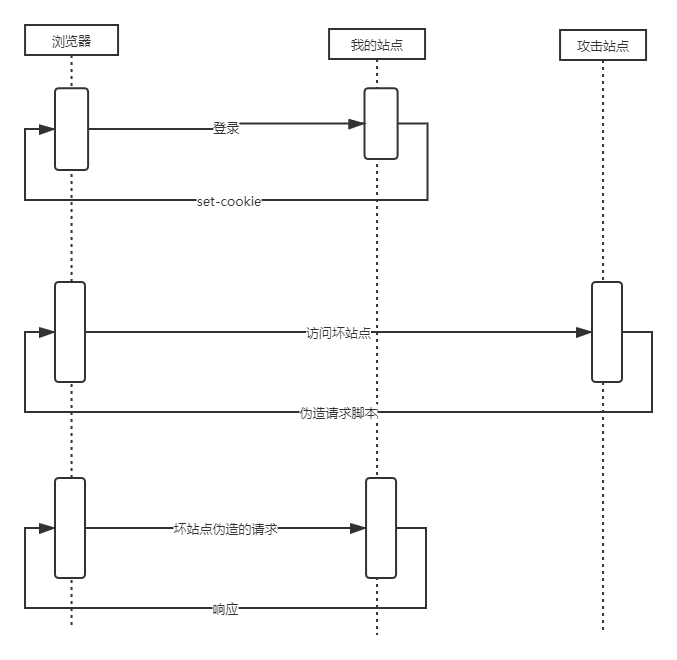简单整理一下cookie的跨站攻击,这个其实现在不常见,因为很多公司都明确声明不再用cookie存储重要信息,不过对于老站点还是有的。
攻击原理:

这种攻击要达到3个条件:
用户访问了我们的站点。
用户通过cookie存储和传递身份信息
用户访问了坏站点
1和3根本控制不了,那么控制的就只有2,就是不使用cookie。
但是有些站点改动太大,那么是否还有其他方式呢?
防御方式:
不使用cookie存储和传输身份认证
使用antiforgerytoken,anti-forgery 防伪。
避免使用Get作为业务操作的请求方式
那么从上面看可以在2上做文章,因为3只是说让低级黑客被阻挡。
同样antiforgerytoken 方式也有两种:
那么就来演示一下:
下面问我们的站点,提供的cookie身份认证方式:
var securityKey = new SymmetricSecurityKey(Encoding.UTF8.GetBytes(Configuration["SecurityKey"]));
services.AddSingleton(securityKey);
services.AddAuthentication(CookieAuthenticationDefaults.AuthenticationScheme)
.AddCookie(CookieAuthenticationDefaults.AuthenticationScheme, options =>
{
}).AddJwtBearer(JwtBearerDefaults.AuthenticationScheme, options =>
{
options.TokenValidationParameters = new TokenValidationParameters
{
ValidateIssuer = true,
ValidateAudience = true,
ValidateLifetime = true,
ClockSkew = TimeSpan.FromSeconds(30),
ValidateIssuerSigningKey = true,
ValidAudience = "localhost",
ValidIssuer = "localhost",
IssuerSigningKey = securityKey
};
});
上面是cookie和jwt的认证方式哈。
那么下面这个是cookie登录:
[HttpGet]
public async Task<IActionResult> CookieLogin(string userName)
{
var identity = new ClaimsIdentity(CookieAuthenticationDefaults.AuthenticationScheme);
identity.AddClaim(new Claim("Name", userName));
await this.HttpContext.SignInAsync(CookieAuthenticationDefaults.AuthenticationScheme,new ClaimsPrincipal(identity));
return Content("login");
}
那么有一个接口是购买接口:
[ApiController]
[Route("[controller]")]
public class OrderController : Controller
{
[HttpPost]
[Authorize(AuthenticationSchemes = JwtBearerDefaults.AuthenticationScheme+","+CookieAuthenticationDefaults.AuthenticationScheme)]
public IActionResult Pay()
{
return Content(User.FindFirst("name").Value+"买买买");
}
}
上面认证方式有cookie和jwt了。
那么我们先使用cookie进行登录一下,调用CookieLogin这个接口。
https://localhost:5001/Account?username=aomaomao
以看到前台有cookie信息。

在另外一个站点有这样一个东西:
<form action="https://localhost:5001/order" method="post">
<label>打折购买:</label>
<label>1块钱</label>
<input type="submit" value="提交"/>
</form>

那么点击一下这个提交后:

可以看到这样就被攻击了。
那么可能有人就会说,如果自己看了一眼网站地址应该就不会出现问题吧。
其实一般攻击站点一般不给你点击的机会。
<script>
document.form[0].submit()
</script>
这一段代码在进入网站的时候就自动帮你点击了。
services.AddAntiforgery(options =>
{
options.HeaderName = "X-CSRF-TOKEN";
});
services.AddMvc(options => options.Filters.Add(new AutoValidateAntiforgeryTokenAttribute()));
上面这个代码进行Antiforgery验证,通过header里面的X-CSRF-TOKEN的值。options => options.Filters.Add(new AutoValidateAntiforgeryTokenAttribute()是自我判断是否应该验证的机制。
可以看下AutoValidateAntiforgeryTokenAttribute的源码:
public IFilterMetadata CreateInstance(IServiceProvider serviceProvider)
{
return (IFilterMetadata) serviceProvider.GetRequiredService<AutoValidateAntiforgeryTokenAuthorizationFilter>();
}
那么继续看AutoValidateAntiforgeryTokenAuthorizationFilter:
internal class AutoValidateAntiforgeryTokenAuthorizationFilter : ValidateAntiforgeryTokenAuthorizationFilter
{
public AutoValidateAntiforgeryTokenAuthorizationFilter(
IAntiforgery antiforgery,
ILoggerFactory loggerFactory)
: base(antiforgery, loggerFactory)
{
}
protected override bool ShouldValidate(AuthorizationFilterContext context)
{
if (context == null)
throw new ArgumentNullException(nameof (context));
string method = context.HttpContext.Request.Method;
return !string.Equals("GET", method, StringComparison.OrdinalIgnoreCase) && !string.Equals("HEAD", method, StringComparison.OrdinalIgnoreCase) && (!string.Equals("TRACE", method, StringComparison.OrdinalIgnoreCase) && !string.Equals("OPTIONS", method, StringComparison.OrdinalIgnoreCase));
}
}
看ShouldValidate,里面说明了get,head,trace,options都不会进行验证,post delete等其他的才会验证。
如果你怕这个把握不住的话,那么你可以设置属性:
[HttpPost]
[ValidateAntiForgeryToken]
[Authorize(AuthenticationSchemes = JwtBearerDefaults.AuthenticationScheme+","+CookieAuthenticationDefaults.AuthenticationScheme)]
public IActionResult Pay()
{
return Content(User.FindFirst("name").Value+"买买买");
}
直接在方法上加入ValidateAntiForgeryToken即可。
那么我们还是按照前面的方法进行演示一下。

这里表示的就是400了,bad request。
先这样,细节篇会介绍是具体是如何验证的,在DefaultAntiforgery这个类里面。
下一节重定向攻击。
重新整理 .net core 实践篇————cookie 安全问题[三十八]
原文:https://www.cnblogs.com/aoximin/p/14984428.html